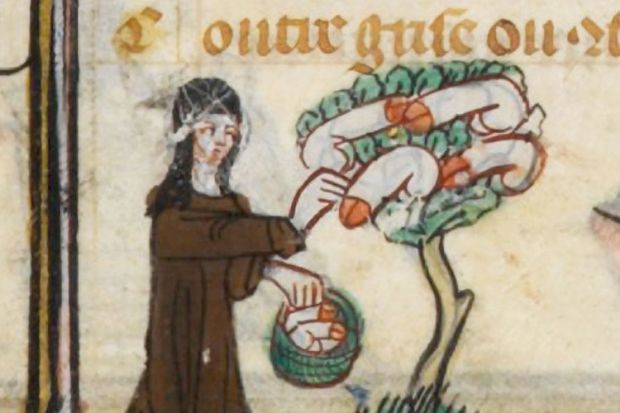You can get some strange reactions if you start posting rude pictures on Twitter.
That was what Sarah Peverley, senior lecturer in the University of Liverpool’s School of English, discovered when she decided to tweet an image from a French manuscript showing nuns picking “fruit” from “a medieval penis tree”.
One male follower noted that the penises “look pretty much like those I drew on my maths book, c.1995”. Another “hesitate[d] to mention the pussy willow”. A third asked: “How do they know which fruit is ripe?”
A woman wondered “if Santa Claus delivers them for Christmas”, and someone calling herself The Book Mistress said she realised that she definitely didn’t “spend enough time with medievalists”.
Strangest of all was the man who wanted to tell Dr Peverley about a “seriously freaky novel” by Alfred de Musset, his “favourite nun-porn author” besides the Marquis de Sade. A later tweet elaborated that de Musset’s 1833 shocker Gamiani: Or Two Nights of Excess involves “lesbianism, murder, orangutan sex”.
Asked about such exchanges, Dr Peverley was keen to make clear that she did not spend her whole time tweeting such pictures. Her current research focuses, she said, on “literature produced during the Wars of the Roses, particularly authors such as the chronicler John Hardyng, who wrote during the conflict and who revised or produced new work for the change of dynasty”.
She is also planning “a cultural history of the mermaid”, in which she has “had an interest since I was a little girl. They are one of the world’s oldest symbols, since the dawn of civilisation right through to today. Starbucks has a mermaid as their logo for their coffee sales, so you can see one on every high street, even though it was quite a sexually potent image for most of its history.”
One of this year’s crop of BBC Radio 3/Arts and Humanities Research Council New Generation Thinkers, Dr Peverley said she had “always loved the Middle Ages, its culture and literature” and once told an interviewer that she had refused to listen to an English teacher who advised her to “move on from stories about princesses and knights”.
She has already presented her research on radio and television and, on the principle that a picture is worth a thousand words (and far more than 140 characters), likes to “use Twitter to share an image I find compelling – visually striking or amusing. The mixture of high and low, sacred and profane, comedy and tragedy, are central to mediaeval life. People like the aspects of humanity which link to us today. A tree hanging with phalluses is funny throughout the ages, just like monsters with funny faces.”
She said the penis tree was from a 14th-century manuscript of the Romance of the Rose, a popular and influential medieval French-language poem – and the image was drawn by a woman.
“The manuscript was made by a husband and wife team in Paris and there’s an image of the couple working, with him writing and her illustrating. That makes the image infinitely more interesting.”





